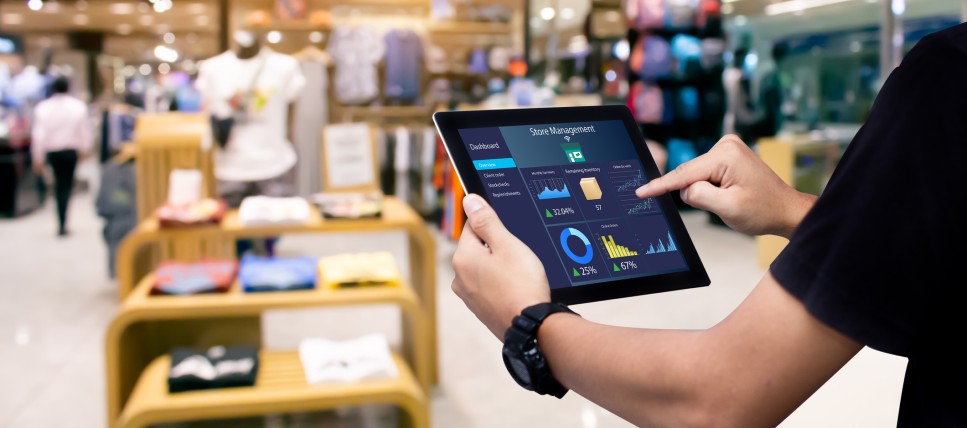Innovative retail technologies help establishments connect with their customers, enhance shopping experiences, and support loss-prevention efforts.
Low-voltage technology innovation in the retail industry is alive and well, allowing retailers to improve profit margins and customer satisfaction. Let’s take a look at emerging innovations and how they’re transforming the retail experience.
1. Bridging In-Store and Online Sales
Brick-and-mortar storefronts had to shift their business models in recent years, with many now offering online orders for pick-up, delivery, and shipping in addition to in-person sales. Managing multiple sales processes requires advanced point-of-sale (POS) and inventory management systems.
The challenge comes in implementing these systems across multiple locations and/or distribution centers. When someone orders an item for pickup, they need assurances that the product will be there when they arrive. Retailers need to monitor and ensure easy payment options, including virtual payments, QR code payments, or only being charged once an order is fulfilled.
Retail technologies are closely tied to fintech innovations and are expected to become more accessible and intuitive as time goes on.
2. AI-Enabled Video for Theft Prevention
High-definition 4K video surveillance and closed-circuit television (CCTV) capabilities continue to advance. Not only are optics improving, helping to eliminate grainy images, but their analytic functions are becoming far more sophisticated. With the help of emerging AI functionalities and algorithms, it’s possible to analyze videos, images, and audio data to identify vehicle makes and models, license plate numbers, and even people with facial recognition technology.
If a past offender or suspected thief enters the store, AI can recognize the individual and send out an alert to security personnel with a photo and their location in the store. It’s critical to consider the ethical or legal implications of such profiling and to keep an eye on pending legislation, however. Some loss prevention experts do not condone such technology, and each organization needs to develop policies that clearly outline its stance on the use of AI technology for this purpose.
3. In-Store Navigation
Not sure where that sale item is kept in the store? Indoor positioning systems (IPS) help users navigate areas to find what they’re looking for using an app that’s synced with the store’s map and on-the-shelf inventory data. The technology can also send push notifications to alert shoppers of targeted deals or product recommendations when they enter an area of the store.
IPS systems can do more than help increase consumer purchases; they can also help employees find items faster when fulfilling orders or when putting returned items back on the shelves. Currently, in-store navigation is more common in major retail stores, but as the technology advances and becomes more accessible, others will be able to take advantage of it as well. A major hurdle is having the right infrastructure in place, including low-voltage technologies like Bluetooth beacons, markers, and WiFi RTT, not to mention the RFID tracking and software that runs the app.
4. AI-Powered Self Checkout
Self-checkout has become common in many retail settings, but emerging AI Internet of Things (IoT) will take things a step further. Advanced RFID sensors will help to automate the buying process for customers.
Some Amazon Go Grocery stores allow customers to walk out of the store without ever going through a check-out line. Data collected from IoT sensors and highly advanced cameras detects when an item is removed from a shelf and placed in a cart, charging the guest only when that item leaves the store.
Such technology will be difficult for smaller retailers to implement, but many existing AI solutions are being designed with scalability in mind and may allow more accessibility to such features in the future.
5. Augmented Reality Shopping
To attract customers to brick-and-mortar stores will require pleasing customer journeys and experiential shopping — an experience they can’t get online. In addition to excellent service, a bright and pleasing atmosphere, and hassle-free shopping, patrons increasingly want an immersive experience, one that gamifies their shopping trip.
Virtual reality has been used for home goods products for several years, allowing shoppers to see what flooring, furniture, or paint colors will look like in their homes. Now, this technology is expanding to clothing lines. In particular, virtual reality allows guests to experience a virtual dressing room where they can see how an outfit will look on their own digital representation. According to the TCS Retail Survey, 60% of millennials are willing to shop or spend more money with a retailer offering virtual fitting rooms or virtual staging capabilities.
6. Mobile POS Systems
Integrating Point-of-sale (POS) systems with CCTV, biometric screening, and access controls combines forces to help identify potential threats or losses. Mobile POS systems will continue to be leveraged in retail to help alleviate labor shortages and inventory loss. Employees can monitor retail space from anywhere in the store and carry their POS devices with them.
Modern POS systems feature audit logs, biometric recognition, and the ability to alert an associate if an inventory item leaves the store without payment, while also holding employees accountable for inventory kept under their watch. POS technologies are increasingly used to limit employee theft, which accounts for more than one-quarter of all retail inventory loss.
Work with an experienced low-voltage technology provider who designs and engineers solutions that are compatible with existing systems and scalable to integrate with those yet to come.
7. Unified Integrations
For retail stores with growing footprints and multiple locations, finding a single source integrator and service team can be a challenge. However, brands with stores nationwide want and need to minimize disparate security systems and vendors to simplify management and standardize.
Brands will seek out providers who can help them streamline operations with a single point of contact and unify their low-voltage technologies. They’ll work with integrators who can deliver, install, and service their systems across all their locations, including:
- Access control and surveillance
- Video analytics
- Facial recognition and other AI-enabled devices
- Wireless networks
- EAS systems
- IoT devices
- And more
At ASD®, we support nationwide rollouts of these types of low-voltage technologies, provide maintenance services, and can work with security teams to streamline their operations and security systems.
We’ve developed an AI in Retail Security eBook — A Guide to Reducing Shrinkage & Retail Theft to help you get started. Be sure to download it today, and reach out to our nationwide team of experts to talk through your biggest technology challenges. We’ll help you take the next step.





Leave a Comment